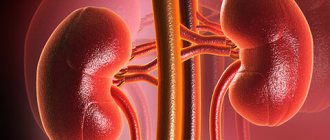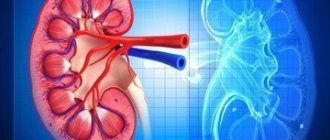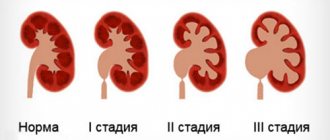Kidney failure in dogs
The kidneys remove waste substances from the blood, maintaining optimal water and mineral balance in the body. However, if they don't do their job, your dog's health and life are in serious danger. Read on to find out what kidney failure is, what forms it occurs in, and how it is treated.
Read in this article
What is this?
Renal failure (RF) is a pathological condition of the body in which the functioning of the kidneys is partially or completely impaired. This inevitably leads to problems with the excretory system, water-salt balance, blood circulation and blood pressure, as well as internal organs.
The risk group includes pets over 5 years of age (in the absence of provoking factors at an earlier age). In this case, you need to be especially careful if your dog belongs to one of the following breeds:
Kidney cells and tissues are not restored, so the diagnosis and treatment of the disease must be approached as carefully as possible, entrusting this task to experienced veterinary specialists.
Causes
In 20% of cases, the cause of kidney failure in dogs cannot be determined. This is due to the fact that owners do not know about possible provoking factors, and the disease is detected already in the last stages of development.
Among the most common reasons:
Amyloidosis and polycystic disease cause difficulty with kidney function in young dogs. This is caused by the accumulation of abnormal white structures and the formation of many cysts filled with fluid.
Leptospirosis, Carré's disease, viral enteritis or hepatitis are just some of the acute infectious diseases that can trigger the development of kidney failure. This is due to the fact that pathogenic microorganisms penetrate the renal tissue, disrupting the functioning of the kidneys.
Certain diseases can cause kidney damage and pathological changes, provoking the development of renal failure. Among them: glomerulonephritis (glomerular nephritis), pyelonephritis, nephritis, nephrosis, etc.
Piroplasmosis and hemobarthenelosis destroy and also block the activity of red blood cells, exerting a toxic effect on the entire body as a whole. As a result of the release of toxins, the kidneys gradually lose functionality, so their work is disrupted.
Severe poisoning is a common cause of kidney failure among dogs of various ages and breeds. Most often it occurs when consuming household pesticides, medications, salts of heavy metals, etc.
The development of liver failure in dogs can be provoked by the most common disease of the urinary system - urolithiasis (UCD), since it is accompanied by compression or complete blockage of the urinary tract.
Other factors can lead to kidney failure: benign and malignant tumors, cysts, severe bleeding with a sharp drop in blood pressure, congenital underdevelopment of organs, etc.
Main predisposing factors
As we have already said, the reasons for deficiency can be very different. The following main groups of predisposing factors are distinguished:
- Nephritis and nephrosis. Pyelonephritis often occurs in dogs, which in many cases contributes to the complete destruction of kidney tissue and makes it impossible for the organ to function.
- Infectious and parasitic diseases. The same leptospirosis, which often affects service and hunting dogs, especially hits the kidneys. The same applies to cases of blood parasitic diseases. The kidneys are extremely negatively affected by the toxins that are released in large quantities by parasites.
- Golden retrievers and some other dog breeds have one hereditary problem called amyloidosis . Naturally, with complete degeneration of the kidney tissue, there is no need to talk about the organ performing its direct work. The prognosis in this case is unfavorable, since these diseases cannot be treated in principle.
- Intoxication, poisoning. It is especially bad for the kidneys when salts of heavy metals enter the body. In some cases, their complete fatty degeneration is observed. The result is similar to cases of amyloidosis; the kidneys cannot fulfill their direct “responsibilities”.
- Cysts on the kidneys. In dogs, there are cases when these formations are nothing more than echinococcus or alveococcus. In some cases, the condition of the organ can be partially restored after professionally performed surgical intervention.
- Neoplasms are benign or malignant tumors. This is especially true for old dogs, especially those who grew up in large cities.
- Stones and sand in the kidneys. This occurs much less frequently than in cats, but dogs are not at all immune from this pathology.
How does kidney failure manifest in dogs?
Detecting signs of kidney failure in dogs in the early stages is problematic. Typically, the first signs appear when about 65-70% of the kidney tissue is no longer functioning. The remaining part is not able to cope with the secretion and purification of blood, which entails various disturbances in the functioning of the body.
Signs of kidney failure in dogs:
The longest period of development of renal failure. The animal's activity, mobility and appetite are normal. There are no abnormalities or symptoms of the disease. The disease can be diagnosed only by taking tests, since the level of creatinine in the blood will be no more than 125 mmol/l.
The main signs are constant thirst and frequent urination. By the end of the compensatory stage, about 50% of the structural and functional units of the kidney (nephrons) die. The level of creatinine in the blood ranges from 125 to 180 mmol/l.
Other signs are added to problems with urination: loss of appetite, sudden weight loss, constant weakness and lethargy, problems with the gastrointestinal tract. By the end of this stage, no more than 20% of nephrons are functioning. The level of creatinine in the blood is from 180 to 440 mmol/l.
The most difficult period of illness, associated with severe intoxication of the whole body, electrolyte imbalance, and poor health. No more than 15% of nephrons continue to “work”, while the level of creatinine in the blood exceeds 440 mmol/l.
How does the disease manifest itself?
So what are the main symptoms? First, the urination pattern changes. The dog begins to urinate a lot more. This is largely due to a sharp increase in thirst (polydipsia and polyuria). The animal’s condition remains completely stable for a long time, without changes. Initially, while the condition of the kidneys is still compensated by the body’s protective reserves, its composition remains virtually unchanged, but subsequently its density quickly decreases. A microscopic examination of such urine can reveal many cells exfoliated from the inner surface of the renal pelvis. The dog drinks more and more, and is tormented by constant calls to urinate, and up to 40% of them are false. Due to the constant accumulation of nitrogenous bases in the blood, the dog’s skin sometimes begins to smell of ammonia; for the same reason, massive stomatitis appears, the treatment of which with conventional methods does not give any effect.
It should be noted that the concept of “renal failure” includes damage not only to the kidneys themselves, but also to the adrenal glands. Their “failure” can be much more noticeable. For example, a dog’s blood pressure may rise sharply to a critical level. By the way, experienced veterinarians have one diagnostic method associated with this feature: the fundus of the eyes is checked in dogs with suspected renal failure. If it is full of hemorrhages, the diagnosis is almost always positive. And further. If your pet’s vision suddenly begins to deteriorate, you urgently need to take him to the veterinarians: it is possible that the problem is even more serious than one might think. Subsequently, the dog loses weight and loses its appetite completely. Periods of severe profuse diarrhea alternate with constipation. This is due to the ever-increasing autointoxication of the body. In some cases, severe nervous phenomena (seizures, constant trembling) and death from cerebral encephalopathy are possible.
Forms of renal failure: acute and chronic
The nature of the manifestation of symptoms of renal failure in your pet depends directly on the form of the disease - acute or chronic. All signs differ in the brightness of the current and the speed of occurrence.
Chronic renal failure (CRF) usually occurs in adult dogs. It develops slowly but constantly. Before characteristic symptoms appear, the kidneys may lose 3/4 of their functions. The main symptom is extreme thirst, among other symptoms:
Note! The more nephrons are lost, the more severe the symptoms of kidney failure in dogs develop and manifest.
Acute renal failure (ARF) is characterized by the rapid onset of symptoms. It is clearly visible and complex, so the owner immediately notices that the dog’s condition has worsened. Among the main signs:
Does your dog have a similar symptom pattern? Make an appointment with your veterinarian immediately. The sooner you seek professional veterinary help, the sooner your beloved pet will regain its appetite, mobility and good mood!
Causes and stages of the disease
As we have already said, the kidneys are a powerful filter of the body that cleans the blood of various harmful substances. Naturally, this does not go unnoticed for them, and the cells of the kidney tissue begin to gradually die. The work of the dead cells is taken over by the remaining cells and continues to work in an intensive mode, so initially this does not in any way affect the dog’s health.
Most often, renal failure begins to manifest itself in an animal in old age, because the process of cell destruction does not proceed quickly.
The first signs of the disease appear when more than half of the dog’s kidney tissue is affected. At first glance, it seems that with this development of events the animal has little chance of life, but this is not true, since if treatment for the disease is started at this stage, then your pet will be with you for a long time.
There are two forms of the disease:
- Acute renal failure in dogs develops quickly and has all the symptoms inherent in this disease, but is less common than the chronic form.
- Chronic renal failure (CRF) is the most common type of pathology and develops over a long period of time.
Depending on how severely the kidney cells are affected, there are several stages of the disease:
- The initial stage is less than 50% of dead cells.
- Clinical stage - about 50% kidney damage.
- The final stage is more than 70% of dead kidney tissue.
Everyone understands that it is easiest and most effective to treat kidney failure at the initial stage, but to do this you need to catch the first symptoms and immediately go to the veterinarian.
Effective treatment
Treatment of acute and chronic renal failure in dogs is carried out in several directions. Regardless of the stage of the disease, infusion therapy (droppers) with medications that support the general functioning of your pet’s body is prescribed.
Note! Medicines and their dosage can only be prescribed by a veterinarian after an accurate diagnosis.
Do not try to prescribe treatment for your pet at home. Only in a veterinary clinic will it be possible to restore the functioning of the kidneys and prevent the further development of acute or chronic renal failure!
Treatment of the disease
Treatment of a disease such as renal failure in dogs is carried out almost the same in all cases.
Firstly, to relieve intoxication of the body, infusion therapy is prescribed, that is, the introduction of solutions that cleanse the body of toxins. In addition to cleansing, the restoration of lost fluid is achieved, and the dog ceases to feel constant thirst, and the load on the kidneys, which work in increased mode, is reduced.
The schedule for such infusions will directly depend on the degree of the disease, i.e. The more severe the case, the more often the solution will need to be administered. For example, at the final stage the dog has to receive drips or intravenous injections several times a day, but at the initial stage you can get by with subcutaneous injections every few days.
As an auxiliary treatment, infusion therapy can be supplemented with any medications.
And another very important factor in the treatment of kidney failure is the diet that the dog will follow for the rest of its life.
Nuances of nutrition in renal failure
Proper nutrition for a dog with kidney failure prevents the condition from worsening and the progression of the disease. It is recommended to exclude vegetable oils from the diet, while animal fats are not contraindicated. Vegetables should not be given raw: they must first be boiled and then crushed into puree.
It is necessary to exclude all foods rich in phosphorus:
Kidney failure in a dog is a serious disease that remains virtually asymptomatic for a long time. To prevent dangerous consequences, it is recommended to periodically check with a veterinarian and conduct an ultrasound of the internal organs.
Timely treatment of renal failure will save your pet's life and provide reliable support for the functioning of the kidneys!
Source
Treatment of disease in dogs
Kidney failure in dogs at an early stage is quite difficult to determine because the kidneys are a paired organ. If one of the kidneys becomes ill, then the healthier kidney takes over its function for some time. And the body continues to work, seemingly without deviations.
Therefore, before starting treatment for a dog’s kidney failure, the doctor must prescribe a number of tests and examinations. In this case, the veterinarian will ask the owner about the dog’s living conditions and its usual behavior. And also clarify what has changed in the animal’s behavior recently. The tests, x-rays, and ultrasound examinations allow us to fully reveal the picture of the pet’s disease. Based on this, the doctor makes an appointment.
This diagnosis requires hospital treatment. The same drugs are used for therapeutic treatment for acute renal failure and chronic renal failure. When treating acute renal failure, the cause that led to the attack is eliminated. And with chronic renal failure, the goal is to maintain the vitality of the pet. With this disease, the animal experiences severe intoxication. First of all, it needs to be eliminated.
- The animal is injected intravenously with a buffer composition, glucose, and a physical solution in the form of droppers.
- In addition, the liver and heart are supported by certain drugs.
- Blood transfusions, if necessary, can sometimes also support the life of a pet.
- The use of an “artificial kidney” is also possible. But this will require very large costs.
- To improve the general condition of your pet and improve digestion, you need to take vitamins and probiotics.
- In addition, the doctor prescribes medications for the tailed patient that can lower blood pressure, and also requires pills or injections that calm the nervous system.
- To maintain health, a diet for dogs with kidney failure is very important.
It should be noted that the life expectancy of a pet depends on the stage of the disease, its type, as well as the conditions in which the animal is located.
Kidney failure in dogs: causes, symptoms and treatment
Kidney failure in dogs : causes and symptoms - the first thing that will allow you to pay attention to your pet in time. A pet is not only a cold, wet nose, cozy snoring at night, kisses in the morning. This is also a colossal responsibility, which can be a real shock for the owner. But there is no need to panic, in this article we have collected the most relevant information that will help you understand the situation. Remember that we are responsible for those we have tamed.
What is kidney failure?
With age, the kidneys stop functioning at full capacity. And accordingly, this organ wears out, like the dog’s entire body as a whole. Because of this, a wide variety of toxins begin to enter the body, which kill the animal day after day. If the disease is left unattended, the kidneys fail altogether.
Kidney failure in dogs develops gradually; there are several most striking symptoms. It is clear that at the very beginning the disease can be eliminated completely, but not all owners know how the symptoms go and how they differ from each other. Let's look at them in more detail.
Main symptoms
As stated above, kidney failure in dogs does not develop overnight.
Be sure to seek medical help if you notice the following symptoms :
All these signs of chronic renal failure in dogs should alert any normal owner, who should immediately seek veterinary help at any time, day or night. “But I work a lot! I don’t have time,” some will object. In this case, you should contact “YA-VET” for help. We have a modern and convenient service - calling a doctor to your home. This is very convenient, for example, if you work late.
The renal form of renal failure poses a threat to the health of the animal. In such a situation, you should not self-medicate and listen to the advice of friends.
Any doctor tries to identify the true causes of the disease. Do not forget that the most important organ that suffers from this disease is the kidneys. To avoid having to connect your pet to an artificial kidney machine, every owner must know all the stages of the disease.
Acute renal failure: symptoms
Acute kidney failure is a dangerous condition
, which
threatens intoxication and poisoning of the body
.
However, with proper and prompt attention to a doctor, it can be completely eliminated. The animal becomes very lethargic , refuses to eat , and its body temperature rapidly rises . The nose becomes hot .
All these signs should immediately make the owner grab the animal and run to the veterinarian
, or what’s better - invite a specialist to your home, because every minute counts, which can be decisive! If measures are not taken in time, the animal may die.
What are the reasons
Kidney failure develops quickly, within a few hours, to a maximum of days; this type of kidney damage is often (but not always) reversible. Animals of any age get sick.
Acute renal failure in a dog can be caused by:
Symptoms of kidney disease in dogs
A fairly serious disease is kidney failure. The kidneys do not completely remove substances that poison it from the pet’s body. Phosphorus, calcium, vitamin D3 are poorly absorbed and the acid-base balance throughout the body is disrupted.
A number of infections and toxic substances cause kidney disease. The disease develops due to previous illnesses, all kinds of injuries, and even due to low-quality products. This disease can be transmitted genetically. Age-related changes can also cause kidney failure. The concept itself refers to a disease not only of the kidneys themselves, but also of the adrenal glands.
Certain symptoms indicate that your pet is suffering from kidney failure. Please note if
- The dog constantly drinks and suffers from endless thirst. During the day, the animal, having healthy kidneys, drinks up to fifty milliliters of liquid throughout the day. This is based on one kilogram of weight. In case of renal failure, the dose of water consumed is increased to one hundred milliliters.
- When a dog has kidney failure, the amount of urine excreted increases significantly. A dog can go to the toilet six to eight times a day. Over time, the kidneys no longer produce the required amount of urine. As a result, she doesn't stand out at all.
- Decreased appetite may not be accidental. This is one of the most severe signs of this disease. At first, the animal begins to pick at its food. Then he doesn’t eat even what is offered to him. He is losing weight sharply. As a result, the dog refuses to eat at all.
- Your friend has stopped frolicking. He doesn't care. He has become lethargic, sleeps a lot or just lies down. This condition of the animal may indicate that the dog is developing kidney failure.
- Vomiting is also one of the symptoms of this disease. At the onset of the disease, vomiting is rare. But over time they become more frequent. This phenomenon can occur after every meal or simply drinking water. The pulse quickens.
- Swelling appears.
- The mouth becomes inflamed and ulcers appear.
- Vision drops sharply.
- Indigestion and constipation alternate.
Acute renal failure in dogs
The acute form of this disease has a distinctive feature: it develops extremely quickly. It is necessary to consult a specialist in time so that he can make the correct diagnosis. Under this condition, it is possible to cure this disease, as far as possible in each specific case, although this will require enough time. Another difficulty is that the acute form is quite rare. There are a number of factors that lead to the onset of the disease.
- So nephrosis or nephritis entails complete destruction of kidney tissue.
- Worms and the toxins they produce lead to kidney disease. A variety of infectious diseases in dogs quite often entail acute renal failure.
- There are a number of congenital diseases in which the kidneys cannot cope with their immediate responsibilities.
- It is possible that poisoning also causes this disease.
- A cyst in a dog interferes with the functioning of the kidneys. But after its removal, the organ is completely restored.
- A tumor can trigger the onset of disease.
- One of the factors may be sand or a kidney stone.
The kidneys begin to work poorly if
- various types of poisoning occur,
- there are parasites in the body,
- lack of fluid in the body,
- pathogenic microbes have entered the blood,
- state of shock.
The surge arrester is divided into the following groups:
- Prerenal.
At the same time, the pressure drops sharply. This is possible if there is not enough fluid in the body or due to heat stroke.
- Renal.
In the kidneys, tissue and cell damage occurs. This can be caused by pyelonephritis, drug poisoning.
- Post-renal.
In this case, the ureter is compressed and possibly clogged. This means the presence of stones in the kidneys and ureters. ARF, if it is already secondary, becomes incurable.
Chronic kidney failure in a dog
There are acute and chronic renal failure in dogs. The acute form of renal failure is very rapid in its development. And if you turn to a specialist for help in time, who can quickly and correctly diagnose, you can help your pet. The chronic form of renal failure often occurs in dogs,
- Who lived six years or more. But not only age can cause the disease to develop.
- It may be a genetic inheritance.
- And also the surge arrester, which formed much earlier.
The trouble is that the onset of kidney failure in a dog is not noticed by the dog owner for the simple reason that the disease does not have pronounced signs. And, therefore, no one is very alarmed. The first signs of chronic renal failure are:
- Poor appetite
- Weakness.
- The results of tests and certain tests indicate the presence of the disease.
- Increased thirst.
At the first stage of the disease, the dog remains active and playful. The kidneys still cope with their functions and manage to cleanse the blood. This is facilitated by a large amount of urine. Further, the kidneys can no longer cope with their duties and this entails a deterioration in the animal’s health. It becomes obvious:
- Weight loss,
- Endurance.
- The animal's activity is lost.
- The dog drinks a lot.
- Urine output becomes less and less each time. And false urges appear.
- The fur becomes dull.
- Saliva is viscous. The body becomes dehydrated.
- The temperature drops to thirty-seven degrees.
- Bradycardia appears. Pulse rate less than sixty beats per minute.
- The smell of ammonia comes from the dog's mouth.
- Vomiting or vomiting occurs periodically. In this case, undigested food is visible.
- Swelling of the extremities occurs quite often. Although this does not always happen.
- The kidneys gradually shrink in chronic renal failure.
The owner of a four-legged friend with such symptoms simply needs to go to a specialist. After all, the pet urgently needs help.
Treatment
Treatment of a disease such as kidney failure in dogs should be carried out exclusively by a veterinarian, who will inject the animal subcutaneously with a drug that helps enhance the release of toxins from the body. In addition to infusions, the doctor may prescribe other medications that will help alleviate the symptoms of the disease, for example, painkillers, laxatives and others. The doctor makes any prescriptions based on the owner’s words, and therefore any questions from the veterinarian should be answered as fully and honestly as possible.
Treatment of renal failure in dogs should be carried out exclusively by a veterinarian, since it is he who will be able to select an adequate treatment that corresponds to the current condition, symptoms, and age of the animal. Also, in addition to chronic renal failure, there is also acute, in this case this condition is a direct threat to the life of the animal. The disease develops very rapidly, while chronic renal failure develops quite slowly.
Symptoms of acute renal failure are as follows:
All these signs of chronic kidney disease in dogs should alert any normal owner, who should immediately seek veterinary help at any time, day or night.
Which dogs are at risk?
All dogs are susceptible to kidney failure, but there is a particular risk between the ages of 5 and 8 years.
. It is during this period that animals are most susceptible to this dangerous disease.
What to feed a dog with such deficiency
One of the conditions for the treatment of acute renal failure and chronic renal failure, as well as your desire to prolong the life of your pet, is nutrition. A properly selected and balanced selection of products will enable your four-legged friend to live a full and joyful life again. To do this, again, you need to listen to the opinion and advice of a specialist. At the same time, you can prepare dishes for your pet yourself. You can also use special food for this purpose, buying it in specialized stores or veterinary pharmacies.
When choosing food for dogs with kidney failure, you must adhere to certain requirements. But the most important requirement when cooking is to strictly limit the use of salt. It is salt that is the main enemy for those suffering from kidney failure. And if the owner values his pet, he will carefully adhere to this rule.
But fats in food should be in sufficient quantities. They are necessary to restore your pet's vitality. Your dog's diet should include eggs, butter, and high-fat yogurt. But you should not use vegetable oil for cooking. When preparing dishes at home, you must remember that fats should be introduced gradually and in small portions so as not to upset the functioning of the stomach and intestines.
Protein foods cannot be completely excluded from the diet. But you still have to limit it. You can give your pet two whites and only one yolk. You can include eggshells in your diet. Just before serving, you need to chop it well. This use of shells will allow phosphorus to be absorbed. For half a kilogram of any cooked food, you only need one gram of crushed eggshells.
Consumption of dairy products
Milk and products containing milk and bones should be administered with some caution and in small quantities. The amount of foods that contain phosphorus directly depends on the severity of the disease. The more complex the degree of the disease, the less phosphorus should be in the animal’s diet.
Carbohydrates that have a low amount of phosphorus should also be used when feeding a dog suffering from kidney failure. You can prepare dishes using semolina and rice, as well as white potatoes.
Another very important factor in dietary nutrition is water. Tap water should never be used for cooking, especially for an animal suffering from kidney failure. Therefore, water is taken for culinary products and simply for drinking, only filtered.
If your pet does not want to eat, then it is better to prepare him the dishes that he likes. Pamper your pet with delicious dishes. As the dog recovers, it will eat whatever is offered to it.
There are special dry foods for dogs (more details) suffering from kidney diseases. And their range is quite diverse. But before you buy such food, you need to make sure whether it is suitable for your pet.
It is worth knowing that transferring a dog to a regular diet is possible only after certain treatment and tests, with the permission of a doctor. This is possible if your four-legged friend is diagnosed with acute renal failure. In case of chronic renal failure, dietary nutrition is constantly observed and cannot be abandoned. If in the old days older dogs suffered from kidney failure in dogs, now PN has become younger. And many younger pets suffer from this disease. Take care and love your pets.
Currently reading:
- Detection of endocardiosis and its treatment in dogs
- What to do if your dog has heart failure
- Thyroid dysfunction in dogs (hypothyroidism)
- Seven Signs and Remedies for Getting Rid of Fleas in Dogs
Is kidney failure treated with herbs?
Many owners, having learned about this disease, begin to search for information on the Internet, and having found information about herbal treatment, they try to help the animal in this way. Chronic kidney failure cannot be treated with herbs alone
. There must be medications that will help relieve symptoms and treat kidney failure, depending on the stage.
Attempts to treat traditional medicine only waste such precious time. Veterinary doctors strongly recommend never procrastinating and bringing your dog in for a routine examination in a timely manner.
Diet for illness
If there is acute renal failure in dogs, then the animal’s diet should be carefully reconsidered.
. The vast majority of veterinarians believe that proper nutrition plays a significant role in an animal's recovery.
- So what should a dog receive in order to achieve the long-awaited recovery from kidney failure in dogs?
What to do if you suspect kidney failure is beginning
If you suspect that there is renal failure, first of all, you need to visit a veterinarian. Only within the walls of a veterinary center can a comprehensive examination of a pet be carried out. However, if it is not possible to personally visit a veterinary center, you can always use the services of professional veterinarians who are ready to provide all the necessary assistance, even in taking tests at home.
It is recommended that you familiarize yourself with the pricing policy of our veterinary office. She is more than adequate. People with any income level can benefit from the help of our professional doctors.
Thanks to modern technologies, a unique opportunity has emerged to take a test and get results at home in less than 40 minutes. Many will say that this is fiction, but nevertheless it is reality. There is no longer any need to expose a sick animal to stress by transporting it to a veterinary center.
Source
Dog with chronic renal failure, how to help?
Hello! Help me please! This is the situation.
Dog, 16 years old, male, not neutered, spaniel mix, medium, weight 14 kg.
Creatinine 422.1 Urea 66.9 Alt 125.8 Protein 85.2 Alpha amylase 3035.2 alkaline phosphatase 525
I'm shocked. By chance, in a store, a girl suggested another doctor, we came to him on the other side of Moscow, did an ultrasound (also attached below), measured blood glucose (normal), took a urine test (attached), inserted a catheter and prescribed IVs once a day:
And according to the results of a urine test, Sinulox 250 mg, 3/4 tablets 2 times a day for 7 days.
They began to drip. I know how to give IVs and injections, I’ve done them many times, but I’ve never had such problems. At first, the catheter was not washed at all, even when they pressed the syringe with force, they checked it and moved it to the other paw in the clinic, after that the drip dripped very slowly, although the system was correctly configured and the catheter was normal and the paw was lying correctly, they again rushed to the veterinary station, the doctors said that it might be thrombophlebitis (?!) and low blood pressure, the veins are bad, drip as you drip, in the end we sat and drip slowly literally all day long, rushed back to the clinic and moved the catheter again to the other paw and it started dripping normally, then something... then it went wrong again (although the dog with the catheter didn’t do anything, didn’t fall on him, nothing!) and the solution began to pass by, the whole paw was wet, as a result the dog’s paws were all punctured, and we tortured ourselves, tortured the dog and tortured the doctors at the nearest veterinary station, went there 5 times.
Creatinine 381.8 Urea 35.22 Alt 306.3 Protein 70.4 Alpha amylase 1957 alkaline phosphatase 363.6
He said to drip for another five days, the rest will be reported later. It was the 31st, we received the tests and quickly talked to the doctor on the phone.
At home, the dog lay down and got up, drank water, ate! He peed and walked around the apartment as if nothing had happened. Then he lay down like that again. I was afraid that I wouldn't survive the night. Survived.
I don't know what else can be done. In two clinics we were told to live until it got really bad and to be put to sleep. Do what you want, try different things, the end is the same, we can’t tell you anything new. The doctor who prescribed the drips did not clarify anything more about the new tests except that “drip the same thing for another five days,” and did not pick up the phone. The doctor who advised me on how to relieve pain also had no phone number available. They write different things on the Internet, but still everyone has different tests and must be considered individually.
Since the moment we were told that he had chronic renal failure, the dog has been eating Royal Canin Rental food in cans. I feed him little by little, he eats a quarter or a third of a jar at a time and refuses to eat any more. Apparently it’s not tasty, because... he asks for meat and other things and is ready to devour them, but now we don’t give him anything other than food. We finish the jar in a day (in the feeding recommendations, that’s how much he weighs). He refuses to eat dry Renal Royal Canin. In the morning I give Enterosgel, in the morning and evening Omez and Canephron, as prescribed, as well as Sinulox, today we finished taking it. Today (1st) and yesterday there were no droppers, because... Yesterday he felt bad and I was scared that this was the end, but today again the solution I washed went past the vein, the paw was wet, I removed the catheter.
I have options: Either take the dog for the umpteenth time, insert a catheter and still drip, because... At least the numbers have gone down.
Or leave him alone, feed him and give him enterosgel with omez and canephron and inject him with painkillers for cramps. But I don’t know if it’s possible to throw a load on it like that and if it’s worth it. I didn’t inject analgin and dexamethasone anymore, as not to make it worse. Maybe you can give me some advice.
I also heard about ketosteril tablets, but firstly, I don’t know whether we need them and whether we can have them and in what doses, and secondly, they are expensive. Ipakitine, as two doctors said, is just a food additive and does not affect the general condition much, but is just as expensive. I also heard somewhere about a certain lespenephril, but not a single doctor told us about it and it is not clear whether it is necessary or possible, I will not give it at random. Our indicators are not so high, but it’s still terrible, and there are also spasms. And I’m afraid that with my desire to do better, I might exhaust and ruin the dog with my obsessive treatment. Maybe it’s really better not to drag him around to doctors and let him live in peace, I don’t know anymore.
Etiological factors
The disease is a syndrome that indicates problems with the entire urinary system in dogs. The modern understanding of renal failure has changed, new causes of pathology have been found.
Fact! The breadth of known causes and symptoms does not allow for a single treatment regimen. The disease is still a headache for veterinarians.
Acute renal failure and chronic renal failure in dogs do not have clear age boundaries, unlike cats, in which chronic pathology after 6 years is practically the norm.
In older dogs, signs of kidney failure appear for natural reasons due to the aging of the body and the development of degenerative processes.
Fact! Acute renal failure is an irreversible pathology, it is severe, and changes in the excretory system of the kidneys are recorded.
There is no direct breed predisposition to kidney failure in dogs. It is more appropriate to talk about the high probability of developing diseases that can provoke pathology (amyloidosis, polycystic disease, poisoning, parasitic infections).
Periods of development
The mechanism of the disease syndrome is easier to understand when each subsequent stage is clearly explained.
The period is insidious, long, and takes up almost 90% of the time the disease develops. There are no symptoms, the pet appears healthy. A timely urine test helps to recognize the problem earlier.
It is characterized by an increase in functional renal disorders, but without going critical; everything is clear; a urine test may show partial changes in kidney function. Diagnosis is made by ultrasound.
The epiphany stage is where the first symptoms of renal failure appear. Urinalysis is bad.
Critical stage, kidneys practically do not work. The likelihood of developing renal coma is high. The syndrome is divided into prerenal, renal and postrenal types. Each of them has its own processes that lead to pathological functioning of the kidneys.
Prerenal, develops as a response to insufficient blood supply to the paired organ, often when using poor quality anesthesia.
Renal, often occurring, occurs when the kidneys are exposed to viruses, bacteria, toxins, and poisons.
Postrenal, observed in old dogs, with urolithiasis, helminthic infestation, obstruction of the bile ducts.
Fact! CRF develops with prolonged exposure to pathological factors on kidney tissue. The nephrons die, the organ ceases to function normally.
Stages of development
Renal failure syndrome does not occur “suddenly.” The process can be divided into several clearly distinguishable stages. Let's list them in more detail:
- Compensation stage. Occupies up to 90% of the time of disease development. At this moment, the animal looks and feels absolutely healthy, jumps and plays without experiencing absolutely any inconvenience. Only a urine test carried out in a well-equipped clinic can reveal the true state of affairs.
- "Hidden" period. Morphofunctional disorders begin to gradually increase in the renal tissue, but they are still far from reaching the critical point. A urine test, as in the previous case, will show the presence of pathology, but the biochemistry of the blood will not yet reveal any abnormalities. Sometimes at this stage, renal failure can be detected by having an ultrasound performed by an experienced specialist.
- Stage of decompensation. The first signs appear that something is wrong in the dog’s body. The animal's general condition is deteriorating significantly, but the dog continues to drink. A urine test will show a sharp deterioration in its quality.
- Terminal stage. The kidneys have already failed or are close to failure, the animal may fall into a renal coma.
Clinical manifestations of renal failure
It is difficult to make a diagnosis quickly due to variations in the presentation of the disease among different dogs. Pay attention to:
Typical posture for kidney failure in dogs: hunched over, arched back, swelling, periodic vomiting. Signs of dehydration gradually increase, the skin becomes dry, the coat becomes dull, the eyeballs sink into their sockets, and the saliva becomes viscous.
Violation of nitrogen metabolism is expressed in the smell of urine from the mouth and from the fur. The heart rhythm is disturbed, the temperature is slightly lowered.
The final, terminal stage, if untreated, is characterized by the appearance of neurological symptoms, seizures, loss of orientation, shock and coma.
Signs by stage
In the acute form, it is not necessary to display all the symptoms, but even 1-2 signs should alert the owner. A veterinarian's help is needed if there is sudden depression, a change in the frequency of urination and the volume of fluid drunk. You need to be wary if the dog lies down more, there is weakness in the paws, a staggering gait, visible swelling forms in the dewlap and front legs.
A distinctive feature of acute renal failure is the rapid increase in symptoms. The pet may fall into a coma within 24 hours. Delivering the animal to a veterinary clinic or calling a doctor at home is required!
In young individuals, chronic renal failure occurs when treatment of acute renal failure is ignored, with congenital renal anomalies or concomitant diseases associated with the excretory system.
Dying nephrons do not regenerate; if the kidney area is damaged by more than 50%, the symptoms are very pronounced:
A dog with chronic renal failure looks exhausted, unhealthy, and signs of anemia increase. Without help, the pet dies and lifelong maintenance therapy is required.
Kidney failure: treatment
A positive result is possible if you contact a veterinary clinic in a timely manner. In the acute form, the factor provoking acute renal failure must be eliminated; in chronic renal failure, maintenance (lifelong) therapy is effective.
It is recommended that in case of frequent relapses of the disease or in the acute phase, place the dog in the ICU. This way you can monitor the dynamics of the disease around the clock, take frequent tests and see the results of treatment.
Kidney failure in puppies is often congenital and it is impossible to restore kidney function. Symptomatic, supportive therapy makes it possible to live a relatively stable life, but the dog will not have a full life.
Disease prevention and prognosis
The disease cannot be ruled out; there are many factors that provoke the pathology. A preventive examination 1-2 times a year, tests, ultrasound and a number of additional manipulations will allow you to identify a kidney problem in time and begin treatment.
They exclude the pet from access to chemicals and poisons, and promptly treat them against internal and external parasites. They follow a diet, remove low-quality food from the diet, and provide filtered (well) water.
Acute renal failure, detected almost immediately, is an opportunity to restore kidney function with almost no consequences, the prognosis is cautious or favorable. Chronicity of the pathological process, lack of therapy and constant exacerbations, the prognosis is unfavorable.
Source
Diagnostics
As we have already noted, the primary stage of the disease does not have pronounced symptoms, and it is difficult to determine it using laboratory tests, since the kidneys are still doing their job well, despite the changes that have begun in them.
When the clinical stage approaches, a blood test for urea and creatinine reveals an increase in these indicators, and this is what makes it possible to understand that the dog has diseased kidneys.
If you have even the slightest suspicion that your pet has kidney problems, then you need to periodically take tests to determine the level of urea and creatinine and, if they approach the upper limit of the norm, discuss further actions with your veterinarian.










